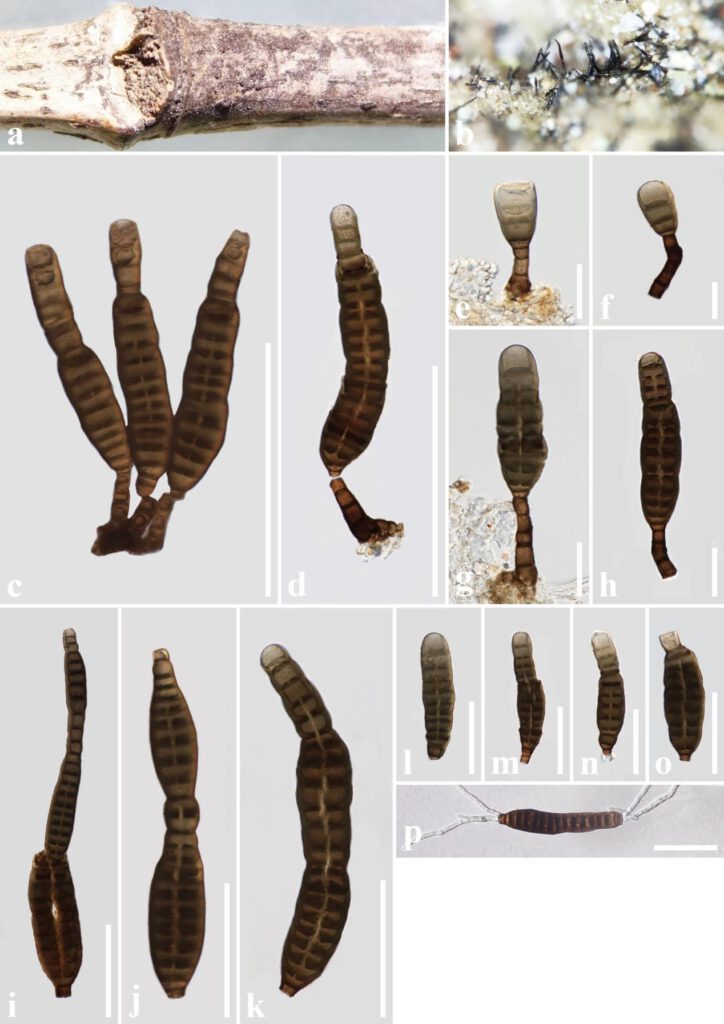Distoseptispora kunmingensis T.Y. Du & Tibpromma sp. nov. Fig. X
MycoBank number: MB; Index Fungorum number: IF; Facesoffungi number: FoF 12955
Etymology: named after the city from which the holotype was found, Kunming.
Holotype: XXXXXXX
Saprobic on dead culms of bamboo (Bambusaceae). Sexual morph: Undetermined. Asexual morph: Hyphomycetous. Colonies superficial, gregarious, brown to dark brown. Mycelium mostly immersed on host substrate, septate, branched, pale brown to dark brown. Conidiophores 22–38 × 6–10 μm (x̅= 30 × 8 μm, n = 20), macronematous, mononematous, septate, unbranched, erect, cylindrical, singly or in groups, straight or slightly flexuous, slightly constricted at septa, wide at the base, brown to dark brown, thick-walled, smooth. Conidiogenous cells holoblastic, monoblastic, integrated, determinate, terminal, subcylindrical, brown, smooth. Conidia 60–195 × 14–27 μm (x̅= 97 × 21 μm, n = 30), acrogenous, solitary, thick-walled, smooth, clavate, cylindrical, oblong or irregular, slightly curved to curved, slightly constricted at septa, 9–35-distoseptate, mature conidia split from the middle, and there is a clear separation between mature conidia and immature conidia, brown to dark brown, usually paler to pale brown towards apex, rounded at apex, with a truncate base and faintly to heavily pigmented scar.
Culture characteristics: Colony on PDA, circular, white, dense, light grey mycelium in the center, entire margin. In reverse, olivaceous to dark gray.
Material examined: CHINA, Yunnan Province, Kunming City, Kunming Institute of Botany, on dead culms of bamboo in terrestrial habitats, 24 March 2021, S.C. Karunarathna, KMD7, holotype, XXXX, ex-type living culture, XXXXX.
GenBank numbers LSU: XXXXXX; ITS: XXXXXX; SSU: XXXXXX; TEF1: XXXXXX.
Notes: Distoseptispora kunmingensis forms a sister taxon of D. guizhouensis (GZCC21-0666) with 100% ML and 1.00 PP support (Fig. X). However, there are some morphological differences in D. kunmingensis and D. guizhouensis in conidia clavate, cylindrical, oblong or irregular, slightly constricted at septa, mature conidia split from the middle, and there is a clear separation between mature conidia and immature conidia. While conidia of D. guizhouensis are obclavate, rarely slightly constricted at septa, and the figures show mature conidia did not split from the middle, and there was no obvious separation between mature conidia and immature conidia (Hyde et al. 2021b). Thus, we consider D. kunmingensis as a novel species from bamboo in China.

Fig. X Distoseptispora kunmingensis (XXXXXXX, holotype). a, b Colony on dead culm of bamboo. c-h Conidiophores, conidiogenous cells and conidia. i-o Conidiogenous cells with conidiophores. p Germinating conidium. q, r Colony on PDA from above and below. Scale bars: c, d = 100 μm, e-h = 20 μm, i-o = 50 μm.
